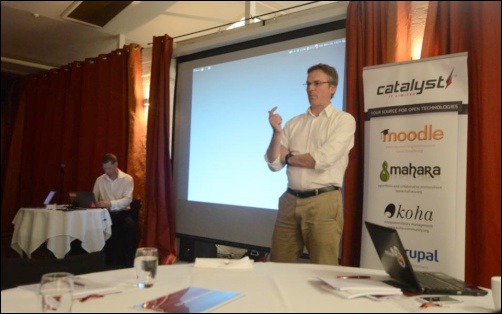Disrupting The Cloud - #OpenStack in NZ With Catalyst IT
By Alastair Thompson and Peter Kerr
Animation of the OpenStack code build ( via Gource )
Today Scoop Editor Alastair Thompson attended Catalyst IT's #OpenStack "Disruptive Technologies" Event in Auckland. He tweeted about the event on @althecat using the hashtags #openstack and #disrupt.
OpenStack is the world's fastest growing open source project. It enables you to run what amounts to a version of Amazon Web Services on a laptop. The same software is being used by the Large Hadron Colider at CERN to process the mountains of data produced in the hunt for the Higgs Boson.
The visuals embedded in this story are animations of the build process for OpenStack showing the amazing growth in the developer community since launch of the project in 2010. The animations illustrating this story are drawn by Gource an open-source software tool developed by Andrew Caudwell from Catalyst IT.
The feature that follows was written by Peter Kerr of StickNZ.Net.
While many people are abstractly talking about ‘being in the cloud’, not as many realise that they can now fly into its implementation.
Ten year developer and open source technologist Aurynn Shaw has seen a number of different technologies come and go, but to her it is perfectly clear that whether public or private, onshore or offshore, the cloud is where everyone will drift to – sooner if not later.
The expat Canadian who, like a large number of Wellington’s IT workforce, has been part of Weta Digital, is now part of Catalyst IT’s six-person team dedicated to OpenStack – open source software which in effect provides a cloud operating system. Shaw’s also a big fan of simple solutions to IT headaches, where non-proprietary systems make much more sense than being locked into specific vendors.
Over 12,000 worldwide code developers are working under the OpenStack Foundation, collaborating to provide free and open-source software under a project kicked off by NASA and Rackspace Hosting in July 2010.
“OpenStack is ahead of the curve because it recognises that different elements within anyone’s IT infrastructure can be sourced by no-brand suppliers, and put together in smart, efficient and effective ways,” she says.
“Because OpenStack’s open-source it is better. It is faster, has more eyeballs, fewer bugs. Its speed of development is light years ahead of proprietary development, where instead of one company and a small pool of engineers, you have thousands of developers working to make it better.”
“OpenStack makes more sense. It is cheaper and easier for IT administration staff and their managers, it provides a consistent platform design.”
And though Catalyst IT are currently the only New Zealand member of OpenStack and its Foundation; which also includes Hewlett-Packard, IBM, CERN and AT&T among others; because it is open-source code, others can provide OpenStack services. (Indeed, anyone is free to download its approximately 100,000 lines of code). In reflection of OpenStack’s origins, Catalyst is also happy to provide the backend expertise for others selling cloud solutions to their own clients.
Equally, it is why Catalyst is encouraging government and private sector managers and IT heads to a free ‘Open Ao’ event in Auckland on November 19 which will give the ins and outs of OpenStack deployment – a process that can be as staged and progressive, and as data-sovereignty secure as the client wants.
Wearing her geek hat,Shaw sees now as being the right time for a digital transformation, “and one that managers and others really should know about,” she says.
Amazon Web Services effectively created the cloud-based IT infrastructure market in 2006; utilising spare server storage capacity the company bought to deal with the ‘burst load’ of their Christmas retail business says Shaw.
“That was a ‘hello’ moment for the rest of the IT world,” she says.
“That included NASA, who immediately could see the benefits of having virtual supercomputer powers as they needed it, on-demand and elastic.”
The result, seven years later is OpenStack: the fastest growing project in open source history.
Aurynn says there are now 40 separate components being developed under OpenStack – which can best be thought of as layers or components required to make the entire cloud engine work from an individual client point of view.
“This revolutionises how IT services will be delivered, and the platforms that will be built,” says Shaw.

Catalyst IT Director Don Christie and today's event
Catalyst founder Don Christie is well aware of the value that cloud computing will make to all businesses, everywhere.
IT services and infrastructure is core to how businesses run, but it is not what they actually deliver, says Christie. IT is a tool that delivers something like a website, a backend database or an HR system, though companies have to divert a lot of resource to providing these ICT tools.
“The IT capex is a separate budget item, that requires money to be set aside, the process of investigating and deciding what to install, and then the maintenance and disciplines of running the whole system,” he says.
“It takes a lot of time and money, when the business doesn’t want to be doing this sort of stuff as such. They want to be improving the business itself.”
Christie acknowledges that some businesses will have valid concerns about how secure their data is in the cloud, and hence be initially reluctant to commit to a such a disruptive technology.
“The beauty of OpenStack is that systems administrators have full control through the layered and simple to understand software, and can virtually network their devices and increase and decrease storage as required,” he says.
“But instead of having to physically connect and disconnect devices, or laboriously configure newly added hardware to the rest of the system’s software, administrators can easily manage and change their operations themselves through a web dashboard.”
For this reason Christie describes OpenStack as reducing business headaches, and immediately providing “more flexibility, more power and more agility in terms of cost.”
The fact that OpenStack is also infinitely scalable from a few users, up to enterprise level, and again all managed from a web dashboard, means government and business should now be starting to understand why and how they can plug into the cloud environment.
Christie says that from Catalyst’s point of view, advising and assisting clients into the cloud requires an understanding of requirements and the current IT infrastructural state. Working around current hardware, a plan can be developed and a raft of services gradually put in place to transition to the new environment.
“How you go about this transition is specific to what the customers’ requirements are,” he says.
“But the deliberate beauty of OpenStack is as much or as little of the hardware and software as is required can be sourced through the cloud – and the administrator can turn it on or off at will.
“There’s a complete transparency, and best of all, customers aren’t locked into the vendor’s proprietary systems and hardware.”
Christie appreciates that IT and business managers, as well as government procurement officials will want to get their heads around cloud computing, and the transition to it under the government-mandated Infrastructure as a Service provision.
“There is a healthy and growing OpenStack community here in New Zealand; come and talk to us,” says Christie. “The cloud is quite manageable, secure and safe with OpenStack as your primary tool. Our Open Ao will show people how to go about it, as quickly or as staged as required.”
ENDS
DISCLAIMER:
This news feature was enabled by Catalyst IT and is a
publication of Scoop Amplifier.



 Binoy Kampmark: The Australian Defence Formula, Spend! Spend! Spend!
Binoy Kampmark: The Australian Defence Formula, Spend! Spend! Spend! Ian Powell: New Hospital Building Trumps ‘Yes Minister’ Hospital Without Patients
Ian Powell: New Hospital Building Trumps ‘Yes Minister’ Hospital Without Patients Mike Treen: Prices Are Still Rising - It's A Cost Of Living Crisis
Mike Treen: Prices Are Still Rising - It's A Cost Of Living Crisis Gordon Campbell: On When Racism Comes Disguised As Anti-racism
Gordon Campbell: On When Racism Comes Disguised As Anti-racism Peter Dunne: Newshub And TVNZ Tip Of Media Iceberg
Peter Dunne: Newshub And TVNZ Tip Of Media Iceberg Harry Finch: Austerity – For And Against
Harry Finch: Austerity – For And Against